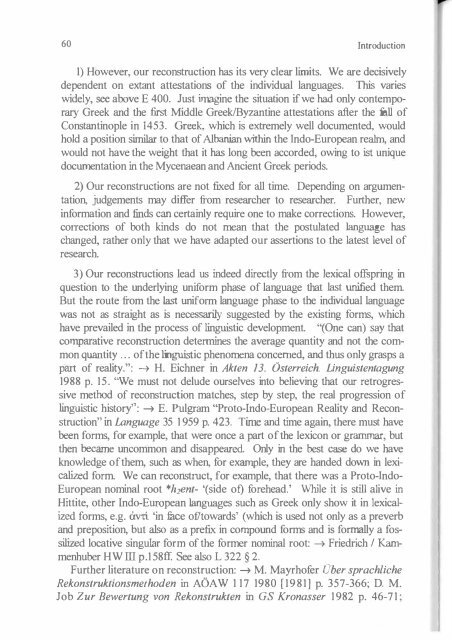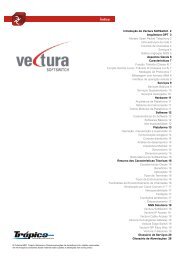Create successful ePaper yourself
Turn your PDF publications into a flip-book with our unique Google optimized e-Paper software.
60 IntroductionI) However, our reconstruction has its very clear limits. We are decisivelydependent on extant attestations <strong>of</strong> the individual languages.This varieswidely, see above E 400. Just imagine the situation if we had only contemporaryGreek and the first Middle GreekIByzantine attestations after the full <strong>of</strong>Constantinople in 1453. Greek, which is extremely well documented, wouldhold a position similar to that <strong>of</strong> Albanian within the Indo-European realm, andwould not have the weight that it has long heen accorded, owing to is! uniquedocumentation in the Mycenaean and Ancient Greek periods.2) Our reconstructions are not fixed for all time. Depending on argumentation,judgements may differ from researcher to researcher.Further, newinformation and finds can certainly require one to make corrections. However,corrections <strong>of</strong> both kinds do not mean that the postulated language haschanged, rather only that we have adapted our assertions to the latest level <strong>of</strong>research.3) Our reconstructions lead us indeed directly from the lexical <strong>of</strong>iSpring inquestion to the underlying uniform phase <strong>of</strong> language that last unified them.But the route from the last uniform language phase to the individual languagewas not as straight as is necessarily suggested by the existing forms, whichhave prevailed in the process <strong>of</strong> linguistic development."(One can) say thatcomparative reconstruction determines the average quantity and not the commonquantity ... <strong>of</strong> the linguistic phenomena concerned, and thus only grasps apart <strong>of</strong> reality.": -4 H. Eichner in Akten 13. Qsterreich. Linguistentagung1988 p. 15. "We must not delude ourselves into believing that our retrogressivemethod <strong>of</strong> reconstruction matches, step by step, the real progression <strong>of</strong>linguistic history" : -4 E. Pulgram "Proto-Indo-European Reality and Reconstruction"in Language 35 1959 p. 423. Time and time again, there must haveheen forms, for example, that were once a part <strong>of</strong> the lexicon or grammar, butthen became uncommon and disappeared.Only in the best case do we haveknowledge <strong>of</strong> them, such as when, for example, they are handed down in lexicalizedform. We can reconstruct, for example, that there was a Proto-IndoEuropean nominal root *"]f!nt- '(side <strong>of</strong>) fo rehead.'While it is still alive inHittite, other Indo-European languages such as Greek only show it in lexicalizedforms, e.g. Qv'ti. 'in fuce <strong>of</strong>7towards' (which is used not only as a preverband preposition, but also as a prefix in compound fo rms and is formally a fossilizedlocative singular form <strong>of</strong> the fo rmer nominal root: -4 Friedrich I KarnmenhuberHW III p.1581I See also L 322 § 2.Further literature on reconstruction: -4 M. Mayrh<strong>of</strong>er Ober sprachlicheRekonstruktionsmethoden in AOA W 117 1980 [1981] p. 357-366; D. M.Job Zur Bewertung von Rekonstrukten in GS Kronasser 1982 p. 46-71;The Reconstruction <strong>of</strong> Proto-lndo-European 61Akten 13. Qsterreich. Linguistentagung 1988 (p. 7ff. Contributions to thepodium discussion: "Sprachwandel und Rekonstruktion," among whichthat <strong>of</strong> H. Eichner (p. 10-40] is particularly fruitful); Language Typology1988 [1991] (among others, H. M. Hoenigswald 'MorphemiC Change,Typology, and Uniformitarianism: A study in reconstruction ' p. 17-26; E.P. Hamp "On Reconstructing Morphology and Syntax " p. 105-110). Formore information see below, end <strong>of</strong> § 4.4) It is important to recognize that linguistic change is not a plann prcess, according to which a language is constructed m an orderly fushion., Alanguage such as German, Swahili, or Italian is a spontaneous systemIt ISthe non-intended result <strong>of</strong> human interaction": -4 R. Keller "Sprachwandel,ein Zerrspiegel des Kulturwandels?" in Kulturwandel im Spiegel des .Sprachwandels, Achtes Partnerschaftskolloquium 1991 in Diisseldorf, editedby K.-E. Lanne. Tiibingen IBasel l995 (= Culture and 0:-vledge 11) p. 13;by the same author, "Zur Erklarungskraft der Naturilchke.'tstheone mSprachwandel and Sprachgeschichte. CommemoratIVe publicatIon for H.Llidtke, edited by J. Schrnidt-Radefeldt and A. Harder, Tiibingen 1993, p.109-1 16; see also by the same author, Sprachwandel l994 (subtitle: Von derunsichtbaren Hand in der Sprache).Further literature on linguistic change and reconstruction: -4 H. Eichner(For title, see above at end <strong>of</strong> § 3); Linguistic Change and ReconstructionMethodology 1990 (which includes, among others, H. M. Hoenigswald"Is the 'comparative ' method general or family-specific? " p.375-383; Diachrony within Synchrony 1990 [1992] (which mcludes,among others, A. Barnmesberger "Phonology, analogy, and how languageschange: Notes on the development <strong>of</strong> some grammatical categoriesin English " p. 359-375; H. M. Hoenigswald "Semantic change and'regularity ': A legacy <strong>of</strong> the past" p. 85-105); "Explanation in ;listoricalLinguistics " 1992 (which includes, among others, R. Anttila , HistOrIcalexplanation and historical linguistics" p. 17-39; B. D. Joseph "Diachronicexplanation: PUlling speakers back into the picture " p. 123-144); HIStoricalLinguistics 1993 (which includes J. Anderson "Parameters <strong>of</strong>syntactic change: a notional view" p. I ff. ; B. Comrie "Typology and reconstruction" p. 74ff.); R. Gusmani, "Ursprache, Rekonstrukt, hermeneutischeModelle" in FS Meid *60 1989 p. 69-77 (further literature may befound in note I.)E 510. The language that is analyzed with the help <strong>of</strong> reconstruction, theIndo-European mother language, called Proto-lndo-European, should notbe considered a 'primitive' original language.Rather, it was a fully 'nor-





